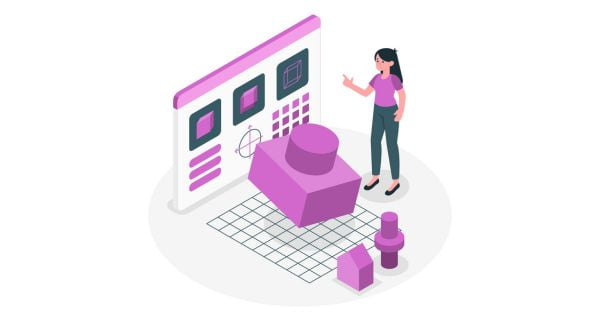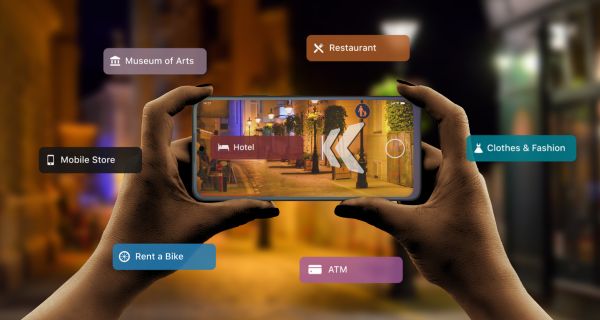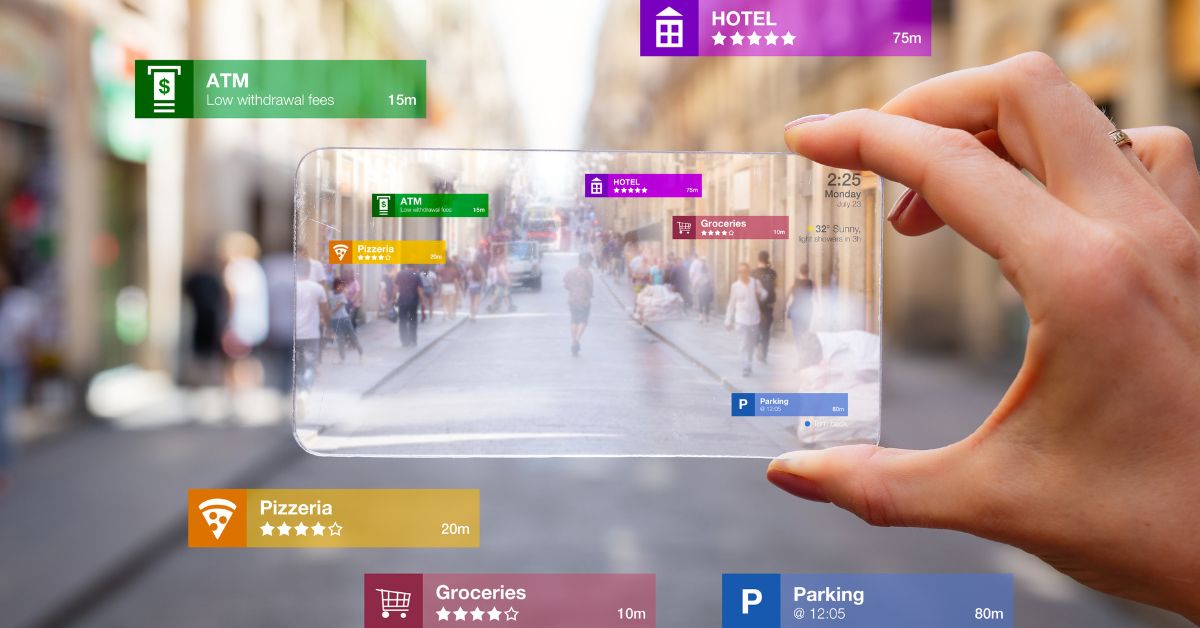AR is one of the most popular categories of games and apps in Google Play. Google’s ARCore and Apple’s ARKit are expanding how Augmented Reality Apps can be used in the real world. AR makes use of your current location to display virtual objects that provide unique AR features to the users.
Many businesses and brands are using AR to create interactive demos and advertising that will provide real-time information to customers.
What is an Augmented Reality App?
Augmented reality, in simple terms, is the overlaying of digital assets (text, sound, image, video, animation) onto the real-world environment that one can experience on a screen. You can understand this better by taking the example of Snapchat filters to augment your looks, like using dog ears and nose over your face, the most famous Snapchat filter. Today, you can use augmented reality apps to try on different types of makeup, you can place Ikea furniture in your homes, or you can also try different shades of Dulux paint on your walls, all via your smart device powered by Augmented Reality.
People with little knowledge of these things need clarification on VR and AR (virtual and augmented reality). As the name suggests, virtual reality is when you experience a virtual world/place. It happens when you wear VR glasses and enter a different world, a movie or a 3D world. In augmented reality, your surroundings and the real world remain the same. There are just digital objects placed in the real world.
The most important aspects you must consider
The first and foremost step for AR app development is to choose the best development kit. But with so many tools available, it becomes difficult to choose the right one. So let us just break down this thing for you first. Here are some major points to consider while selecting an augmented reality SDK or Software Development Kit.
1. Augmented Reality App development cost
People who create an AR application for the first time should go for free, open-source AR SDKs. These free development tools will here be getting a demo for building the app, but if you want to create a full-fledged application with complex and dynamic content, you would need a license hence one of the fully paid versions of these SDKs.
2. AR development platforms
Building an app for your iOS or Android is much easier than doing it for your Windows or macOS. This is because many augmented reality toolkits support your smartphone compared to those supporting your Windows or macOS. However, some augmented reality development kits can be used to build an application supporting the Universal Windows Platform (UWP).
3. Type of tracking
Various tracking techniques are used in 3D and AR development. Marker-based tracking involves attaching markers to the physical object being tracked, and a camera then captures and tracks the tags in real-time. This type of tracking is suitable for projects that require high accuracy and precision, such as medical simulations and industrial assembly lines.
Another major tracking technique, markerless tracking, uses computer vision algorithms to detect and track objects without physical markers. This method is suitable for large-scale projects, such as city-wide AR experiences, but may need to be revised regarding accuracy and robustness.
Additionally, sensor-based tracking uses sensors to track the movement and orientation of an object, making it suitable for robotics and motion capture applications. Each track type has unique advantages and trade-offs, and choosing the right method depends on the project’s specific needs.
4. Pick a cutting-edge no-code tool
No-code platforms are rapidly gaining popularity in the 3D and AR development industry due to their ease of use, speed, and cost-effectiveness. With the traditional approach of creating a Unity AR App, developers require extensive knowledge and experience to create and deploy 3D and AR projects. In contrast, no code/low code platforms enable non-technical users to easily create complex 3D and AR applications. This allows businesses to reduce their reliance on expensive and time-consuming development processes, resulting in faster time-to-market and significant cost savings.
Furthermore, no code/low code platforms provide a more streamlined development experience with pre-built templates, drag-and-drop interfaces, and other visual tools. This enables users to prototype and iterate on ideas rapidly, resulting in faster and more efficient development cycles. No code/low code platforms are also ideal for businesses developing simple 3D and Augmented Reality apps, such as product visualizations or virtual showrooms, without needing advanced technical skills. This democratizes the development process, enabling companies of all sizes and budgets to create and deploy high-quality 3D and AR applications. These platforms provide a faster, more efficient, and cost-effective alternative to creating an AR App with Unity.
5. OpenSceneGraph support
App developers use this toolkit in domains such as augmented and virtual reality, computer games, scientific modeling, and visualization.
6. Cloud support vs. local storage
If you create many markers in your app, storing all that data in your cloud is best advised. This will help you decrease the amount of storage your app uses on your device. An idea of the number of markers you will add to your application is a must because it is one of the deciding factors in choosing an SDK. Not all SDKs support the same range of markers.
However, if you want to run your app offline, without a wifi connection, all the time, then your marker data must be stored in your local storage, i.e., in your device. This is convenient for people not building a more dynamic augmented reality application.
7. GPS support (Geolocation)
If you are creating an app that needs to overlay data on some nearby locations, then the AR tool you choose should support your geolocation. Not only is geolocation helpful while searching for something around you, but it’s also used in many AR games.
8. SLAM support
SLAM refers to Simultaneous Localization and Mapping. It is used in augmented reality apps and many other applications. The main purpose of SLAM is to map the user’s environment and track their movements. This is majorly helpful because it remembers the actual position of the physical objects in any environment and helps to place the virtual objects according to their user positions and movements.
A step-by-step guide to developing Augmented Reality Apps
Following are the steps to developing an AR App from scratch using a coding or a no-code approach:
1. Purchasing an SDK
The development of Augmented Reality software is a tool aimed at helping developers construct augmented reality apps more quickly and without having to develop components developed by other firms. Some of the SDKs commonly used to create Augmented Reality Apps in 2025 are as follows:
- Vuforia – Vuforia is a significant augmented reality development SDK that allows businesses to provide comprehensive AR experiences to their clients.
- Google ARCore – Google ARCore is a popular SDK for developing apps for smartphones and tablets. Position monitoring and detection of objects are the foundations of ARCore.
- ARKit – ARKit is a free and open-source tool for developing augmented reality applications. Despite being an accessible archive, it offers a comprehensive collection of tracking tools.
- EasyAR – This comprehensive SDK provides many functions for building several augmented reality apps.
Augmented Reality Apps for iPhone Vs. Android devices
Developing AR apps differs for iOS and Android devices based on SDK and development approach:
How to create augmented reality apps for Android?
To create augmented reality apps for Android, pick ARCore as your SDK and select a platform where you can build apps that work on Android devices.
How to create augmented reality apps for IOS?
To create augmented reality apps for iPhone or Android devices, pick ARKit as your SDK and select a platform where you can build apps that work on iOS devices.
2. Developing 3D assets

3D development is critical to developing highly engaging augmented reality applications because it enables the creation of lifelike and interactive virtual objects that can be seamlessly integrated into the physical world. 3D development involves creating digital models of real-world objects, environments, and characters using sophisticated software tools and techniques. This enables the creation of immersive and interactive AR experiences that capture the user’s attention and keep them engaged for extended periods.
Furthermore, 3D development techniques enable the creation of dynamic AR experiences that respond to user interactions and changes in the physical environment. This is achieved through sensors and other input devices, which enable real-time feedback and interaction between the virtual and physical worlds. Moreover, 3D development empowers the creation of complex 3D animations and visual effects, which can be used to enhance the overall user experience. Advanced lighting, texture mapping, and other techniques can create realistic and compelling virtual environments that users can explore and interact with.
3. Employing a coding or a no-code, AR development platform
Coding has so far been the most opted method, requiring coders with skills like Unity, C#, JAVA, and XCODE among others. As the number of users grows, technological advances change, becoming more adaptable and simple to use. One such feature is the ability to create an application without coding. Undoubtedly, initially, Augmented Reality required a large workforce of developers.
Today, however, you can build an AR app using a no-code platform without entering a single programming line. Because of no code, businesses save a great deal of money. A corporation’s technical workforce of programmers, developers, and testers is costly. Creating an app without coding allows the audience to interact more efficiently and save time. Various no-code Augmented Reality development platforms can be utilized to develop AR interfaces and applications. One such platform is PlugXR, a no-code cloud-based augmented reality development platform where you can create the best AR apps with a few clicks, publish them on the go, and track performance using advanced analytics.
Industrial Augmented Reality applications

Here are some frequent instances of successful augmented reality deployments in eight different business sectors:
- Hospitals and Healthcare – Enhancing the patient experience during therapy and counseling sessions in healthcare
- Tourism – signboard translation and interpretation in remote regions
- Real Estate – enhanced house purchasing and remodeling experience
- Education – AR-enabled apps for healthcare training and development programs in educational institutions
- Gaming – the interaction of the natural and virtual worlds through simulations.
- E-commerce – Virtual try-ons in retail and e-commerce provide a better shopping experience.
- Automotive – Fully computerized showrooms for automobile exhibition and marketing representation in the automotive industry
- Architecture and design modeling – real-time, automatic adjustments to floor layouts and engineering designs
Benefits of integrating AR into your business in 2025
The unique idea can benefit a variety of industries in a variety of ways, including:
1. Increase sales
Excellent customer service delivered by AR applications helps brands grow sales and net profits. Furthermore, when you provide engaging and engaged customer service, you establish a solid rapport in the market.
2. An advantage in the marketplace
Including Augmented Reality in your company strategy, marketing efforts, direct products, or services demonstrates market readiness, adaptability, and reactivity to emerging technologies.
3. Improve the user experience
Augmented reality app creation can provide your customers with a one-of-a-kind reality experience. Using an AR app may boost client interaction with services and products.
4. Performance enhancement –
AR technology has the potential to help businesses become more efficient. SelfStylo, a feature-rich augmented reality tool, assists you in understanding client behaviors through real-time data analytics. As a result, one can develop marketing tactics that provide personalized assistance to each customer.
Creating an augmented reality app in 2025 is way different than it had been in the past with cutting-edge inventions carried out by tech companies like ourselves. We have revolutionized the process, streamlining it from documenting requirements to purchasing an SDK to designing & optimizing 3D models to creating and publishing powerful Augmented Reality apps on the go. You can create non-commercial, commercial, and white-label AR apps that excel in performance. If you want to know more about what makes us the best choice, book a demo now!

